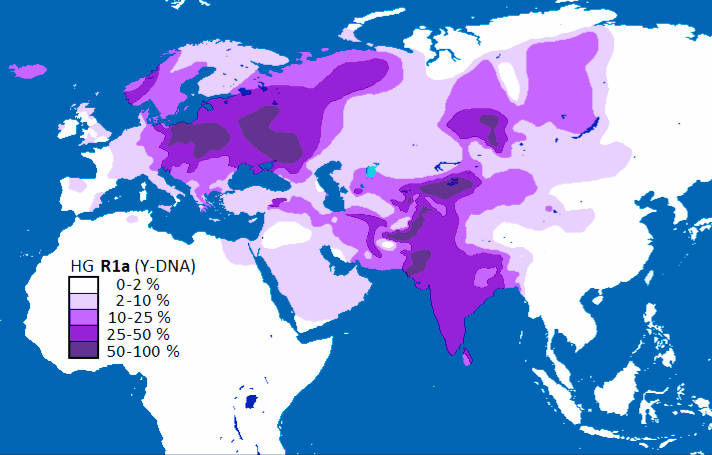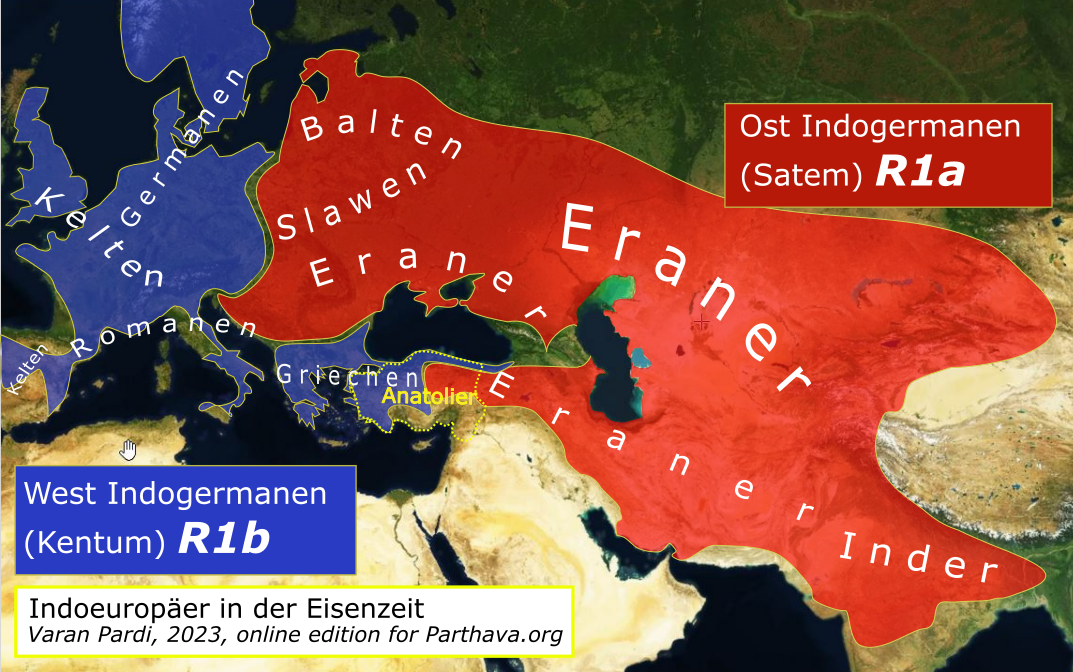The Y-DNA haplogroup R1a is a thread woven through the tapestry of human history. It is one of the most widespread paternal lineages, particularly in Eurasia. In this article, we will unravel the intricate patterns of R1a subclades and explore their connections with ancient peoples and civilizations, based on recent scientific studies.
What is Y-DNA R1a?
Y-DNA refers to the DNA on the Y chromosome, which is passed down from father to son. Haplogroups are groups of similar haplotypes that share a common ancestor. R1a is a haplogroup that is believed to have originated thousands of years ago, and it is prevalent in various regions, including Europe and Asia
Haplogroup R1a, one of the main subdivisions of Haplogroup R, is believed to have arisen on the Eurasian Steppe around 22,000 years ago. It is characterized by several unique genetic markers, including M420, which defines its earliest branching, and Z93, a mutation associated specifically with the spread of Indo-Iranian languages.
Archaeogenetic studies have traced the origins of Indo-Iranian languages to the Bronze Age cultures of the Eurasian steppe. Particularly, the Yamnaya culture and its descendants, the Sintashta and Andronovo cultures, have been associated with the early Indo-Iranians. (Allentoft 2015)
R1a in Sorani Kurds
A recent study conducted by Albarzinji et al. (2022) investigated the genetic markers on the Y chromosome among the Sorani Kurdish population in Sulaymaniyah, Iraq. The study found a predominance of haplogroup J2 in the Sorani Kurds. This indicates a complex genetic history and relationship with other geographical and ethnic groups in the region. Quote:
“In the present study, the second major haplogroup among the Sorani Kurds was R 18.4% (29/157) (R1a = 12,R1b = 11, R2 = 6). The previous results on the Kurdish population in northern Iraq revealed that the major sub-haplogroup was R1a 17.17% (17/104); four other samplesbelonged to R1b sub-haplogroup (4.04%)” (Albarzinji et al. 2022)
Zazas – Parthoid Iranic Y-DNA Haplogroup R1a
According to Hennerbichler (2010) the Zazas have the highest Y-DNA R1a levels in the Orient (Middle East). This makes them close paternal relatives with other Irano-Aryans, Indo-Aryans from northern India, Baltic-, Slavic-peoples and some R1a positive Germanic Clans like the Saxons, Normans and Vikings.
Distribution of Y-DNA R1a1 Near East & Eurasia: “Ukrainians” 50% – 65%, Zaza-Speaker 25.90%, Kurmanji-Speaker Turkey 12.70%, Muslim Kurds N-Iraq 11.60%, “Armenia” 9%, “Tehran” 2% – 4%, “Syrian” 10%, “Lebanese” 9.7%, Ashkenazi Jews 12.70%, Bedouin 9.40%. (Hennerbichler 2010)
While it is true that not all Iranic populations exhibit higher frequencies of the R1a haplogroup within their genetic composition, a comprehensive review of scientific studies confirms that the Y-DNA haplogroup R1a is generally more typical of Iranic peoples (Eran) than non-Iranic (Aneran) ones in the Orient. When compared with non-Iranic populations such as Arabs, modern Anatolian Turks, Georgians, Armenians, Hebrews, Arameans and others, Iranic populations in nearly all instances demonstrate a higher percentage of the R1a haplogroup, especially the subgroups of Z93 and Y17491. This genetic marker can be linked back to their Indo-german Aryan ancestry, which is considered the progenitor of all contemporary Iranic languages.

Fig. 1: Y-DNA Haplogroup R1a1a distribution in modern time
R1a in Ancient Russian Populations
Mustafin et al. (2022) conducted genetic studies on the remains of individuals from mass burials in Yaroslavl, Russia, dating back to 1238. The study analyzed both Y-chromosomal and mitochondrial DNA and found that about 40% of the samples studied did not belong to the dominant haplogroups. Interestingly, the study identified the presence of subclade R1a-Z93, marking the possible “eastern” origin of their ancestors.
Kabaev et al. (2022) presented archaeological DNA data from the XII-XIV centuries from ancient Klyazma settlements. The study identified Y-haplogroups R1a-M458 and I1-Z58 among the population of Northeastern Russia during the medieval period. This supports the presence of Y-haplogroup R1a in medieval Russian lands and hints at a certain genetic unity with the western parts of the Slavic area.
Conclusion
The R1a haplogroup and its subclades are threads that connect us to our ancient past. By understanding these genetic markers, we can gain insights into the migrations, cultures, and histories of our ancestors. The tapestry of human history is rich and diverse, and R1a is just one of the many threads that help us understand the bigger picture. Y-DNA Haplogroup R1a is strongly connected with East Indo-germans and linguistically typical for Satem languages, which also explains the similarities between Balto-Slavic and Indo-Iranian languages.

Fig. 2.: Indo-europeans during the Ironage
List of References
Albarzinji, B. M., Abdulkarim, F., Hussein, S. A., Rashid, D., & Lazim, H. (2022). Population genetic study of 17 Y-STR Loci of the Sorani Kurds in the Province of Sulaymaniyah, Iraq. BMC Genomics.
Borbély, N., Székely, O., Szeifert, B., Gerber, D., Máthé, I., Benkő, E., Mende, B. G., Egyed, B., Pamjav, H., & Szécsényi-Nagy, A. (2022). High Coverage Mitogenomes and Y-Chromosomal Typing Reveal Ancient Lineages in the Modern-Day Székely Population in Romania. Genes.
Mustafin, K., Engovatova, A., Alborova, I., & Tarasova, A. (2022). Genetic Examination of Remains from the Two Largest Mass Burials of 1238 in Yaroslavl Detynets. Archaeology.
Kabaev, D. A., Chernyaeva, L. L., Chernov, S. Z., Goncharova, N. N., & Semenov, A. S. (2022). Archaeological DNA Data from the XII-XIV Centuries from Ancient Klyazma Settlements. Paleoanthropology.
Ferdinand Hennerbichler. 2010. Peter Lang, ISBN 978-3-631-59327-1, S. 58. Die Herkunft der Kurden.
Allentoft, M. E., et al. (2015). Population genomics of Bronze Age Eurasia. Nature, 522(7555), 167–172.
Mapa de R1a” by Maulucioni is licensed under CC BY-SA 4.0. Changes were made to the original image, specifically areas in Eastern Iran and the Zaza region were adjusted according to the mentioned sources. To view the original image, visit: https://commons.wikimedia.org/wiki/File:Mapa_de_R1a.png


